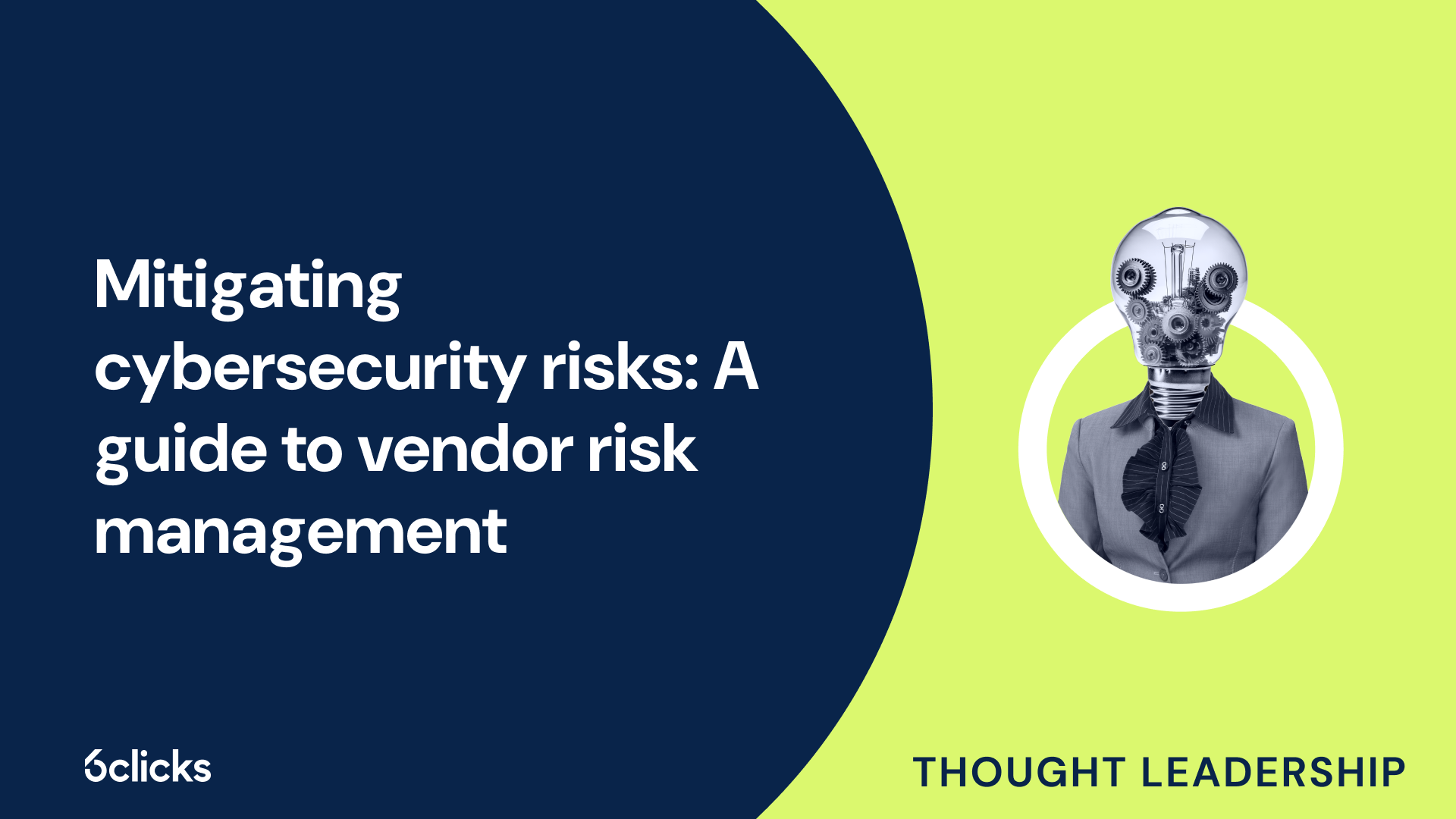Cyber Risk Management Expert Guide
-1.png?width=314&height=391&name=Group%20193%20(1)-1.png)
Cyber Risk Management Expert Guide
What is APRA CPS 234?
APRA CPS 234, also known as the Prudential Standard CPS 234, is a regulation introduced by the Australian Prudential Regulation Authority (APRA) to enhance the cyber resilience of APRA-regulated entities. It sets out mandatory requirements for these entities to ensure they have adequate measures in place to identify, manage, and respond to cyber risks. The aim of CPS 234 is to ensure that APRA-regulated entities have a robust and effective security framework that is commensurate with the size, complexity, and inherent cyber risk profile of their operations. By complying with CPS 234, entities are expected to have effective security policies, controls, and capabilities to prevent and respond to security incidents. The regulation applies to a wide range of APRA-regulated entities, including banks, insurance companies, superannuation funds, and other financial institutions. Compliance with CPS 234 is a critical aspect of operating within the financial sector to protect sensitive information assets and maintain the trust and confidence of customers and stakeholders.
Who does it apply to?
CPS 234, the cybersecurity prudential standard issued by the Australian Prudential Regulation Authority (APRA), applies to a wide range of entities within the financial sector and beyond. This standard is applicable to all entities that are regulated by APRA, including banks, credit unions, deposit taking institutions, superannuation funds, life insurance companies, friendly societies, general insurers, non-operating holding companies, and private health insurers.
The standard is designed to ensure that APRA-regulated entities have robust mechanisms in place to protect their sensitive information assets from cyber threats. By mandating the implementation of security measures and controls, CPS 234 aims to enhance the overall cyber resilience of these entities.
To comply with CPS 234, entities need to establish comprehensive security capabilities that are commensurate with their exposure to cyber risks. This involves developing a sound security policy framework, identifying key security roles and responsibilities, and implementing effective security controls. Entities must also establish incident response plans and conduct ongoing testing and review to ensure the ongoing effectiveness of their cybersecurity measures.
It is important for all APRA-regulated entities in the financial sector, including banks, credit unions, deposit taking institutions, and superannuation funds, to understand and comply with CPS 234 to effectively manage cyber risk and protect their customers' information.
Security capabilities and requirements
To comply with CPS 234, APRA-regulated entities need to establish comprehensive security capabilities that are commensurate with their exposure to cyber risks. This involves developing a sound security policy framework that clearly outlines roles and responsibilities. Entities must identify key security roles and ensure that senior management understands their responsibilities in protecting sensitive information assets. It is crucial for entities to implement effective security controls that mitigate risks and vulnerabilities. This includes conducting regular internal audits and implementing a systematic testing program to assess the ongoing effectiveness of security measures. Incident response plans should be established to enable timely access and efficient incident management in the event of a cyber security incident. By meeting these key requirements, entities can enhance their cyber resilience and better protect themselves and their stakeholders from the ever-evolving cyber threats in today's business environment.
Security policy framework requirements
Compliance with CPS 234, the prudential standard set by the Australian Prudential Regulation Authority (APRA), requires the development and implementation of a robust security policy framework. This framework serves as a guide for apra-regulated entities to address vulnerabilities and threats to their sensitive information assets.
The security policy framework must be commensurate with the entity's exposure to risks and provide clear direction on the responsibilities of all parties involved in maintaining information security. It should outline the key requirements for the entity to operate securely in the current business environment.
Several common areas that should be addressed in the security policy framework include access control measures, lifecycle management of information assets, implementation of information security technology solutions, incident management procedures, and acceptable usage of information assets.
By ensuring that these areas are properly addressed in the policy framework, apra-regulated entities can demonstrate their commitment to safeguarding their sensitive information assets and comply with CPS 234. It is crucial for the framework to be regularly reviewed and updated to adapt to changing threats and vulnerabilities, ensuring ongoing effectiveness and timely access to security measures.
Senior management responsibilities
Senior management plays a crucial role in ensuring compliance with CPS 234 within apra-regulated entities. Their responsibilities include establishing and maintaining a robust information security governance framework. This involves implementing and overseeing effective security controls, allocating resources to address security issues, and reviewing and approving the entity's security policy framework.
Good governance is paramount in complying with CPS 234. Senior management is responsible for establishing and communicating clear roles and responsibilities throughout the organization, ensuring that all staff members understand their obligations in safeguarding sensitive information assets. This includes implementing appropriate security measures, conducting regular training and awareness programs, and promoting a culture of security awareness.
Communication of roles and responsibilities is essential for effective compliance. Senior management must ensure that information security policies, procedures, and guidelines are clearly communicated and understood by all staff members. They should also foster a cooperative and collaborative approach to information security, ensuring that key stakeholders are involved in decision-making processes.
Financial institutions & private health insurers
Financial institutions and private health insurers have a critical role in complying with CPS 234, which aims to enhance the security capabilities and controls of these entities. To achieve compliance, these organizations need to implement robust security measures and mechanisms.
First and foremost, financial institutions and private health insurers should conduct a comprehensive assessment of their security capabilities. This involves identifying potential security vulnerabilities and conducting systematic testing programs to ensure the effectiveness of security controls. It is crucial to have a clear understanding of the risks and threats that the organization faces and to implement security controls commensurate with these risks.
Implementation of security controls is crucial in complying with CPS 234. Financial institutions and private health insurers must establish and maintain a security policy framework that outlines the organization's approach to information security. This framework should include policies and guidelines on areas such as access control, incident management, and third-party vendor security.
Senior management plays a key role in ensuring compliance and the ongoing effectiveness of security policies and incident response plans. They must establish a culture of security awareness and provide regular training programs to all staff members. Senior management should also conduct internal audits to assess the effectiveness of security controls and address any control weaknesses identified.
Timely access to material information security incidents is crucial in complying with CPS 234. Financial institutions and private health insurers must establish robust mechanisms for detecting, responding to, and reporting on security incidents. Incident response plans should be regularly tested and updated to ensure they are effective in addressing cyber risks.
Foreign life insurance companies & life companies
Foreign life insurance companies and life companies that operate in Australia are obligated to comply with APRA CPS 234, just like domestic financial institutions. These entities, including their Australian branches, must establish and maintain robust mechanisms and security controls to effectively manage information security risks.
The compliance obligations for foreign life insurance companies and life companies operating in Australia include ensuring the ongoing effectiveness of the security measures implemented to protect sensitive information assets. This involves conducting regular internal audits and systematic testing programs to assess the robustness of security controls.
The Australian branch of these entities must comply with the same key requirements outlined in APRA CPS 234, which include the establishment and maintenance of a security policy framework, timely access to material information security incidents, and the implementation of incident response plans. Additionally, the branch must ensure that its security capabilities and controls are commensurate with the risks it faces.
As for the head office requirements, the standards set by APRA CPS 234 also apply to them. The head office has a responsibility to ensure that the information security measures and controls implemented across its entire organization, including its Australian branch, are consistently robust and effective.
To ensure compliance with APRA CPS 234, foreign life insurance companies and life companies operating in Australia should take the following key steps:
- Conduct a comprehensive assessment of their security capabilities and identify potential vulnerabilities.
- Establish and maintain a security policy framework that outlines the organization's approach to information security.
- Implement security controls commensurate with the identified risks and threats.
- Provide regular training programs to all staff members to establish a culture of security awareness.
- Conduct internal audits to assess the effectiveness of security controls and address any weaknesses.
- Establish robust mechanisms for detecting, responding to, and reporting on security incidents.
- Regularly test and update incident response plans to ensure their effectiveness in addressing cyber risks.
By following these measures, foreign life insurance companies and life companies can ensure compliance with APRA CPS 234 and effectively manage their information security risks.
Ensuring sound operation of regulated entities
Ensuring the sound operation of regulated entities under CPS 234 compliance involves following key steps to maintain information security and effectively manage threats to information assets. These steps are crucial in meeting the regulatory requirements and protecting sensitive data from cyber threats.
First and foremost, regulated entities must conduct a comprehensive assessment of their security capabilities to identify potential vulnerabilities. This assessment should involve evaluating the existing security controls and identifying any areas that may be susceptible to breaches. By proactively identifying weaknesses, entities can take appropriate measures to strengthen their security measures.
The establishment and maintenance of a robust security policy framework is another vital step. This framework should outline the organization's approach to information security, including policies, procedures, and guidelines for safeguarding data. It provides clear guidance on how to protect sensitive information and ensures consistency across the organization.
Implementing security controls that are commensurate with the identified risks and threats is also crucial. These controls should be tailored to address the specific vulnerabilities identified during the assessment process. Examples of security controls include access controls, encryption, regular system patching, and security monitoring systems.
Regulated entities must also prioritize training programs for all staff members to establish a culture of security awareness. Employees should be educated on the importance of information security, cybersecurity best practices, and their role in protecting sensitive data.
The responsibilities of the Board and other individuals within the institution are instrumental in maintaining information security. The Board should provide oversight and ensure the establishment and ongoing effectiveness of the security controls. They should also receive regular updates on the organization's information security posture and ensure that appropriate resources are allocated to address any identified weaknesses.
Delegating responsibilities to sub-committees and management committees can also enhance information security. These committees can be tasked with specific roles, such as monitoring the effectiveness of security controls, conducting internal audits, and evaluating the organization's response to security incidents. Their input and expertise can help identify weaknesses and ensure timely remediation.
Non-operating holding companies (NOHCs)
Non-operating holding companies (NOHCs) are subject to specific requirements and responsibilities under APRA CPS 234 to ensure the protection of their information assets. NOHCs are required to establish and maintain an information security capability that is commensurate with the size and extent of the threats they face.
To meet these requirements, NOHCs should implement a range of controls aimed at protecting their information assets. These controls may include but are not limited to access controls, encryption measures, regular system patching, and security monitoring systems. By implementing such controls, NOHCs can mitigate the risks posed to their information assets and ensure ongoing compliance with CPS 234.
Furthermore, NOHCs have reporting obligations in relation to material information security incidents. In the event of a security incident that meets the defined materiality threshold, NOHCs are required to report the incident to the Australian Prudential Regulation Authority (APRA) within a specified timeframe. This ensures that APRA is promptly informed of significant security incidents and can take appropriate action if necessary.
It is essential for NOHCs to understand and adhere to these requirements to safeguard their information assets effectively. By establishing and maintaining a robust information security capability, implementing appropriate controls, and complying with reporting obligations, NOHCs can enhance the security of their operations and protect against potential threats.
Security controls and mechanisms
To comply with CPS 234, it is essential for APRAs regulated entities, particularly Non-Operating Holding Companies (NOHCs), to establish and maintain robust security controls and mechanisms. These controls aim to protect sensitive information assets and ensure the ongoing effectiveness of the organization's security capabilities. NOHCs should implement a comprehensive security policy framework that outlines the necessary security measures and roles within the organization. Access controls, encryption measures, regular system patching, and security monitoring systems are among the key requirements for NOHCs. It is also crucial for NOHCs to have an incident response plan in place to promptly handle cyber security incidents. Implementing these security controls and mechanisms not only helps NOHCs mitigate risks and protect their information assets but also demonstrates their commitment to meeting the requirements of CPS 234 and maintaining a sound operational environment. Furthermore, NOHCs have reporting obligations for material information security incidents, ensuring timely access to relevant information for appropriate action to be taken by the Australian Prudential Regulation Authority (APRA).
Additionally, NOHCs should conduct internal audits and systematic testing programs to assess the effectiveness of their security controls and identify any weaknesses. This proactive approach helps NOHCs identify potential vulnerabilities, rectify security control weaknesses, and maintain a strong security posture. NOHCs should also establish strong relationships and clear agreements with third-party vendors to ensure that the vendors' security capabilities are commensurate with CPS 234 requirements. Moreover, NOHCs must provide adequate training and awareness programs for their staff to ensure they understand their security roles and responsibilities. By prioritizing security controls and mechanisms, NOHCs can actively protect their organization, their customers, and the financial sector as a whole from cyber risks and potential security incidents.
Establishing robust mechanisms for compliance with CPS 234
To establish robust mechanisms for compliance with CPS 234, it is essential for organizations to implement effective security controls and measures that align with the requirements of the regulation. This involves developing a comprehensive security policy framework that outlines the necessary security measures and roles within the organization. Access controls, encryption measures, regular system patching, and security monitoring systems are among the key requirements that should be implemented to protect sensitive information assets.
It is crucial to align CPS 234 compliance activities with the organization's overall information security strategy. This means considering relevant standards, regulations, and contractual obligations that may impact the organization's security controls and measures. This includes ensuring compliance with other prudential standards and regulatory requirements applicable to the organization's industry sector.
To ensure that the organization's current security practices are in line with CPS 234 requirements, conducting a Cybersecurity Review or Gap Analysis is recommended. This process assesses and addresses any gaps or deficiencies in the organization's security controls and measures, ensuring compliance with CPS 234.
By establishing robust mechanisms for compliance with CPS 234, organizations can effectively protect sensitive information assets and demonstrate their commitment to maintaining a sound operational environment.
Security roles and responsibilities
Complying with CPS 234 requires assigning clear and defined security roles within an organization. This ensures that the responsibilities for managing information assets and ensuring compliance with security controls are effectively distributed. By doing so, the organization can establish a robust security framework that minimizes the risk of security incidents and enhances its overall cyber resilience.
Key roles that should be established include the Chief Information Security Officer (CISO), who is responsible for developing and implementing the organization's security policies and strategies. The Information Security Manager oversees the day-to-day operations of the security program, including monitoring the organization's security controls and managing security incidents. The Security Operations Center (SOC) Manager is in charge of maintaining the security operations center, overseeing the detection and response to cyber threats.
Assigning these roles provides clarity on security responsibilities and accountability within the organization. It ensures that all employees understand their specific duties and obligations regarding information security. Additionally, regular training and awareness programs should be implemented to educate employees on the importance of security, their individual roles, and the organization's security policies and procedures.
By establishing clear security roles and responsibilities, organizations can ensure ongoing compliance with CPS 234 and mitigate the potential risks associated with security breaches. This approach promotes a culture of security throughout the organization and enhances its ability to detect, respond to, and recover from security incidents effectively.
Developing a security control framework
Developing a security control framework is crucial for organizations to effectively manage their information security risks and protect sensitive assets. The process involves several steps and best practices to ensure a robust and comprehensive framework.
The first step is to identify and assess vulnerabilities and threats that could potentially exploit weaknesses in the organization's security controls. This can be done through regular vulnerability assessments and penetration testing. By understanding the potential risks, organizations can prioritize their efforts and allocate resources accordingly.
Another important aspect is implementing mechanisms to access threat intelligence. This involves staying updated on the latest security threats and trends, such as emerging malware or hacking techniques. By leveraging threat intelligence sources, organizations can proactively identify potential risks and take appropriate measures to mitigate them.
Engaging with stakeholders, both internal and external, is also essential. This includes regularly communicating and collaborating with key individuals and departments, such as senior management, IT teams, employees, and external partners. By involving stakeholders in the security control framework development, organizations can ensure alignment of priorities and seamlessly integrate security measures into business processes.
Finally, developing tactical and strategic remediation activities is crucial to address any identified vulnerabilities or weaknesses. This involves developing and implementing actions plans to remediate issues in a timely manner, as well as continuously monitoring and assessing the effectiveness of security controls.
By following these steps and best practices, organizations can develop a comprehensive security control framework that effectively protects against threats and vulnerabilities, ensuring the ongoing security of sensitive information assets.
Internal auditing and reporting of CPS 234 compliance
Internal auditing and reporting play a crucial role in ensuring compliance with CPS 234. Organizations need to establish robust mechanisms for monitoring and assessing the effectiveness of their security controls. Regular internal audits should be conducted to evaluate the implementation and ongoing effectiveness of security policies and measures. These audits should cover various areas, including security roles and responsibilities, incident response plans, third-party vendor management, and overall security capabilities. The findings and recommendations from these audits should be documented and reported to senior management and relevant stakeholders. This helps in identifying any security control weaknesses or vulnerabilities and enables timely remediation actions to strengthen the organization's security framework. By maintaining a strong internal auditing and reporting process, organizations can ensure that they are compliant with CPS 234 and have a proactive approach to managing and mitigating cyber risks.
Internal audit activities and reporting obligations
Internal audit activities play a crucial role in ensuring compliance with APRA CPS 234, which focuses on enhancing the security capabilities of APRAs-regulated entities. As part of their responsibilities, internal auditors are required to review and assess the design and operating effectiveness of information security controls maintained by related parties and third parties.
The internal audit activities should encompass a systematic testing program to identify any security vulnerabilities and weaknesses in the controls. This includes assessing the security capability commensurate with the nature and scale of operations, as well as conducting internal audits within a reasonable timeframe.
In terms of reporting obligations, internal auditors must provide timely access to their findings, conclusions, and reports to senior management and the audit committee. Key reporting obligations include reporting on the assurance of information security controls, material information security incidents, and the ongoing effectiveness of security measures.
Furthermore, internal auditors should ensure that their incident response plans align with the requirements of CPS 234 and that they have robust mechanisms in place for incident management in the event of cyber risk or security incidents. Compliance with these reporting obligations ensures transparency and accountability in safeguarding sensitive information assets of APRAs-regulated entities.
Related eBooks & Expert guides
- What is CMMC?
- How to achieve CMMC compliance?
- What are the benefits of CMMC compliance?
- What are the major control points of CMMC compliance?
- What are the challenges in CMMC compliance?







